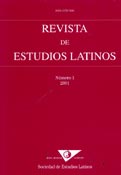Tradición clásica y mitografía: pervivencia del mito de Cibeles en algunos textos latinos de la Edad Media del Renacimiento
DOI:
https://doi.org/10.23808/rel.v5i0.87920Palabras clave:
Cibeles; tradición clásica; Edad Media; Renacimiento.Resumen
La figura de Cibeles sigue interesando a los mitógrafos medievales y renacentistas, aunque sin las implicaciones políticas comprobadas en los clásicos augusteos. No obstante, respecto a éstos es evidente la deuda y continuidad que representan. Pues no se dan enfoques o reflexiones sobre el tema que supongan verdadera innovación. El apego a los textos tradicionales justifica su persistencia en los datos y en la interpretación simbólica. Si bien, la trasmisión textual da lugar en Boccaccio a cambios pintorescos. Gyraldi, entre los humanistas considerados, se esfuerza por ampliar las fuentes clásicas, aunque no consigue zafarse de la tradición medieval. El divulgador Cartari parece abrir nuevas perspectivas en su relato. A su vez el erudito Pierio Valeriano sólo explota a los grandes autores clásicos, y consigue hacer del texto de Virgilio una llamativa interpretación. Quizá es de mayor significación su acogida de las fuentes iconográficas antiguas (monedas, esculturas) como base de sus interpretaciones.
Descargas
Descargas
Publicado
Cómo citar
Número
Sección
Licencia
Derechos de autor 2005 Revista de Estudios Latinos

Esta obra está bajo una licencia internacional Creative Commons Atribución-NoComercial-SinDerivadas 4.0.
Los originales publicados en las ediciones impresa y electrónica de esta revista son propiedad de las personas autoras de los mismos y se podrán difundir y transmitir siempre que se identifique la fuente original y la autoría en cualquier reproducción total o parcial de los mismos, y siempre que no tengan una finalidad comercial.






